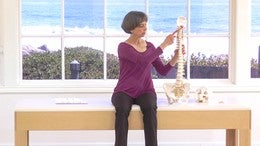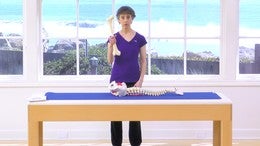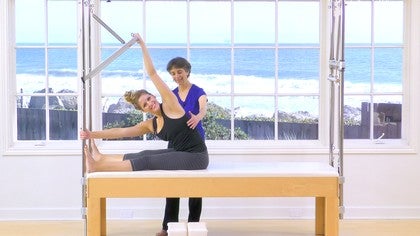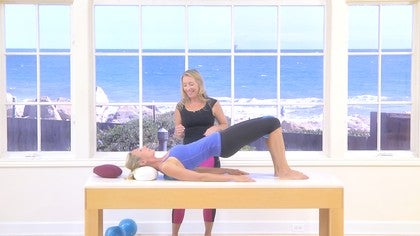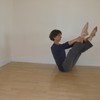Description
It is often thought that gracefulness is inborn; you either have it or you don’t, or it is only the domain of dancers. But grace and agility, and the deeper strength they create, can be achieved by anyone! In this workshop, Ruth Alpert will define and explore the elements that produce graceful movement in Pilates exercises.
Objectives
- Discern the difference between strength and tension
- Discover more freedom and agility in your own body
- Develop your ability to see with accuracy
- Feel flow and grace in Pilates exercises on equipment and Mat work
About This Video
Transcript
Read Full Transcript
Hi, I'm Ruth Alpert and I'm going to talk about what, what we're doing here today. The basis of this is about gracefulness. And I want to tell you a story of why I got interested in it. It wasn't long ago that I had a private client and female client and I was, she hadn't done plots for very long and I was teaching her, you know, a basic reformer workout and we got to the side stretch and she's going over and side stretch and I'm giving her some corrections to improve her form. And she stopped. Suddenly she stops and looks at me and she says, is this going to make me graceful?
I was so moved. For some reason it really struck me because she is a large woman, played a lot of sports in her life and you could tell in that moment that she has never identified as being graceful. And she was probably told a lot that she was not graceful, that she was clumsy, that she was whatever, you know, a lot of injuries came through her sports. Um, and she had in that moment, again, as I was saying, she, I could just see that doing [inaudible] was not only gonna change her body, which those of us who have been teaching awhile, we know it changes bodies, but it was actually going to change her self image and her relationship to herself in a really profound way. I almost burst into tears. I was so moved by that moment and it got me thinking and for the next couple of weeks I just kept thinking, okay, what is gracefulness? Why is it useful? What, what?
And especially for women, you know, I started wondering, do women grace firm to be graceful is almost a requirement to be feminine. And the women's movement of the 70s, sixties, and seventies, that I came of age in, you know, we adopted men's clothing. We adopted men's way of being in the world to try to connect to a sense of power. Um, and how did grace, did we lose gracefulness in that? And was gracefulness almost part of the old image of the Victorian woman who was required to have the graces of, you know, piano playing and painting and all of those social, we say social graces, you know, when somebody's very poised. Um, and it got, I also started thinking about our men graceful, do we say graceful for men? And I started asking the men I knew what word do you use for men?
And some of the words were agile or elegant, but I just riffed, I started riffing off this whole concept of gracefulness and decided that it was really an interesting arena too, or an interesting filter to look at. Polato sees through the filter of gracefulness because if we define gracefulness and think about this for a moment, how you would define it. I also went around asking everybody I knew how they define gracefulness. Um, it has to do with line shape has to do with rhythm. It has something to do with effortlessness.
We say someone is graceful, like an Olympic diver, you know, that's where it applies to men. I think Olympic ice skaters, we say they're graceful because they make it look effortless. Um, which and what's effortlessness and movement really it comes down to being efficient and using just the right amount of energy for the task at hand. Um, a good way to describe, uh, effortlessness is you don't kill a cockroach with a shotgun, right? That's using too much effort for the task at hand.
So when you're doing a movement like roll back or some of the more advanced exercises that your pinky toe is aware of what your shoulder is doing and your whole body is alert and connected and aware of itself and aware of every other part [inaudible]
Change the channel, go watch another V d a video of a Palladio's workup. As I say, this really got my attention just because of what this client said and how profoundly it is to identify as graceful when you've never identified with that. Um, and it can go and reverse. I'm a, uh, I have an alter ego was a flat foot dancer, which is rhythmic footwork in the same family as clogging, but not a different style than clogging, but basically rhythmic footwork to a fiddle and Banjo music. And I've had to work most of my life to not be graceful in it because it's a style that's really a folk dance. And being too graceful takes it out of its origin, so to speak. I can't say I've accomplished being not graceful.
And finally, as I get older, I've just thrown out that, uh, attempt. But it, it's interesting. Um, the other thing about gracefulness is that very often it's assumed that you're born with it. You know, dancers are graceful people look at dancers and I've certainly been on the receiving end of this. We're non dancers, look at dancers and you get a mix of jealousy and separation and all kinds of emotional feelings, especially from women who were blamed for not being graceful. And you look at a dancer, oh she's a dancer. Of course she's graceful. I truly believe that gracefulness can be taught. It's not inborn.
It's something that can be learned and taught. And most of my [inaudible] teaching most of my life has most of my adult life teaching Polonius has been teaching people how to get connected and in essence how to be graceful. So it's just, as I say, another filter and another way to approach thinking about the work. So we'll take a break here and I'll pull up our wonderful demo model for today, DJ and we'll look at some movement. So I'm to introduce DJ my a great model for today. DJ Lee.
Leah Nelo is a in the core dynamics teacher training. Just about finishing up. And we're going to show you some things about, again, what makes gracefulness. The first thing I want to show you is about alignment. When your bones are appropriately aligned, your movement is going to be naturally more graceful.
And when your bones are out of alignment, it's going to create more tension. And then what the viewer sees is 10 moving tension, which is almost the definition of not graceful. So, um, DJ turn to the side and we're gonna look at shoulders because this is a very famous place as plays teachers, we very often say, bring your arms out to your sides. And our clients do exactly what we tell them and they bring them hundred and 80 degrees out to the side. But that's not actually how the shoulder blades are designed in a human body to be in her bone alignment. She has to come a little more in. And did you see how this dropped?
This is her side position standing up or sitting up. This is true side, which you can do when you're lying on the floor, but that has to do with gravity. Once you're upright because of the curl, the waves in your spine, this is actually out of alignment. She moves back in to alignment and the whole upper trapezius relaxes down. Do that a few more times. So she goes back, true side and coming in and again, true side and she finds her support without dropping her elbows. But just so the humorous bone is fitting into the socket, right? And then the muscles relax and were and work.
I mean they're muscles working to keep her arm up, but they're working efficiently and they're not being pinched or, or, um, strained. Okay, so this is gonna come into play in hug a tree, side stretch in the mat, work and twist. Any time your arms are out to the side. Also when your hands are here, it's the same alignment issue. So let's look at it in side stretch. So do you try, you're sitting on the Cadillac. I've put boxes under her feet. It's really important that you have a floor because when your heels, your whole, the sole of your foot, including your heel is anchored down, your tailbone and your lumbar spine will be in a better relationship to themselves and to your legs with your legs just hanging. It tends to pull your pelvis down. Um, her feet are long and one moon box sideways meant that her heel was off.
And I really want her heel connected. So I just took two moon boxes for the length of her feet. So she's going to go into a side stretch. In your old way, she's hyperextending your elbows. This is in the disconnected way. Her arm is, uh, she's learned it so well already. She can't do it or old way. Her arm was back this way, true side.
And she goes over and she's hyperextending and go too far, go all the way out and she's hanging off the ligaments here and there is some degree of disconnection.
So she follows this line for both hands and then she goes over dropping her shoulder and the rib cage moves and she doesn't hang slightly. Bend your elbow so that you're not hyperextending and she goes over
That's not necessarily part of [inaudible] doesn't have to be part of [inaudible], but I'm adding it in as an element of gracefulness. So you reach through your fingers, think about the arc, the rainbow arc you're making. Yeah. And she comes down and notice I'll get out of the way so that you can see the line of the movement, the line of the space, the joints in the right, appropriate, um, connection, arms. Getting too far back again. So slightly more forward. Yep. And one more time.
Oops, you lost it. Go on out one more time. No.
So we're going to demonstrate first the regular saw because the circular saw somebody added the circle, the original saw, go into it. You're um, oh, I always get this hand is there and this hand is there and it's the pushing here and the polling here that creates the tension without hyper extending and without hunching. He both sits bones down and that's your saw. And then you switch to the other side. Plain old fashioned Saul. If your DJ's arms are quite long and so she can reach the pole.
If your uh, arms are shorter or your legs are longer and the proportions are off, you can use a magic circle. I'm going to go get a magic circle and show you this. What I do for people with short arms hold. This is all pull away so that they still have a tension. 10 filed opposition. Good.
Okay. So all right. So then we're gonna add circular salt onto this or the circular part of thought. So you go into saw, you start from saw hand the other way please. So that it can easily move elbows, hyper extending your elbows will disconnect your shoulder stabilizers and support across your back. So if you have hyperextended elbows, it's really important to bring them into alignment. Go ahead and hyper extend again. Big Time. Watch what happens here.
And soften your elbow and hyper. Extend
Yeah. There you go. That's it. And this part, this corner is an important piece of it. Good. Do the other side just so that everybody can see both angles of it. Good. And she circles and she follows her hand and does the whole circle and circles back to there. Yes. There she goes.
And pull up in here and now co round back. It's almost like a rollback and she circles around and then circle through this corner. And teacher has to get out of the way because you can get knocked over by a long arm. Good. And one more time. Circle. Feel your hand moving through this space over the top. Yeah. And come back in. Okay.
We're going to look at hanging up, which is an advanced exercise, but also is a really great place to look at. Disconnected versus connected movement. So we're going to do hanging up. I like to get people into it. One leg at a time just for safety. So she takes one leg up and then the other leg and you hang and give yourself a moment here because it's so delicious to get that traction on your spine.
She's gonna press down with her feet to connect her tail up. So the hamstrings are connected. She comes up, she connects right under here. Good. And then back to plank. For pull-ups, which DJ does very well, two of them. And then she drops her pelvis and her head comes up. Good. The way she did that one very well, a disconnected way.
The way you first did it is you just hoist your pelvis up and you'll hyper extend your neck and you come do that one more time if you can. So she's not connected here. Her shoulders are rounded and her neck is trying to do all of the arching instead you need a break. Okay. So what I'm asking her to do here is connect her shoulders through the lat, serratus anterior and lower traps and all of that support to get the arch to come from here. So her neck stays in line, her head stays in line with her spine and her neck. Doesn't. The minute your head does this, look what it does to your shoulders.
Not to mention my voice, but if the head, what's the word? Like when you get hung decapitated, this is decapitating your head and it's your shoulders. Your upper traps are going to go into high gear to keep your head from falling off. And so right away you're going to get this kind of movement, which I think we can all agree it's not very graceful, nor very safe, nor very healthy, nor very good pallet's form. Good. So let me do it one more time. One more time with that in mind. Right. So press down with her feet to see, saw her tail up and she connects right under here.
Right there. That's the operative place. Good. And then come all the way down. Beautiful. And come on out. Great. The next thing we're going to look at is the roll back. So we'll take this off and you can just turn around and we'll just put this under here. Now the rollback is a very basic beginning exercise, but it's a very famous place for dis for being disconnected.
So do a disconnected rollback, right? Ah, she's already too good. So start from here. No, start curling from here. Yeah, right. You say curlier back in. A lot of people think that their back is above their pelvis because the pelvis has a different name and the neck has a different name. So a lot of clients will think that this is the back and that's what they try to curl. What actually needs to happen?
Uh, slide in so your knees are bent, come really close and keep your heels on the Poles. So not that close, right? The first thing I want her to do is to push into the Poles with their feet. Do, do just a little curl back a little and now come up and straighten all the way onto your sits bones. And now push with your heels and come up. Do that a few times. What the heel, except you're compressing your spine.
So push without compressing. Yeah, there you go. Can you see that? Once she gets the back of her leg connected, it goes right into her tailbone and, and sits bones. So that's the pelvic floor connection. That's the beginning of the roll back. One more time and roll all the way back. And now keep going without compressing, right?
Keep the length in your spine and you come up. Legs are straight as long as possible. And then you bend your knees so that you can get right up on your sits bones and let your spine habits, normal curves. So press and keep it long. Yeah, there's still a little compression going on. And exhale and roll.
Next piece is her neck. Bend your knees, come in onto your sits bones, press into your heels, roll back. And then the other piece to this is keeping your head long. I start with your nose, but no more than that. Now you're going to drop your sternum and come up without tucking your Chin because [inaudible] do that again. Tuck your Chin too much. Uh, as you roll back, right. Look what happens to her shoulders when she's in this place.
So what you need is for your head to stay on top of your spine, your, your neck to stay long. I go over this a lot in, in the workshop that was filmed a couple of years ago on this, uh, spine and head. Yes. Much better.
So turn around. Yeah, Lake Spring. So on your back, just lie on your flat on your back. So the first thing before she gets in, as a teacher, I can't tell you how many times I've got them in the leg springs and then went to look, if they're centered on the machine and they're not, and then they have to do the Palladia scooter, I have to take them out and send her employment back in. Take it from me. The first thing you do is you stand here, you look at your client, you say, put your hands on the Poles, push out until your, your arms are more or less than a handstand where you can connect the push use, make sure they're centered. Then you say, thank you very much. I'll hand you the leg springs. Nope. And you knock your client out by swiping them with the strap. Okay. So in the, uh, just the leg lowers up and down.
What you want to look for is the articulation of the socket. That's better. So the pelvis stays very quiet, just like in the sow as work that we just did before. You want, I don't want to block you, but you want the articulation so that you can actually sense and feel the femur dropping back down into the socket. So there is a clarity to the movement. Now do it over tucking and overworking your muscles, but stay down. Don't hike up. But um, well that was a good one.
Oh, I'm flatten your back over over talk. Press your back down too much and move your legs.
She's connecting here and release on the way up. So release on the way up. Lengthen your pelvis. Yeah, good circles. In the same way you want as circular saw, you want to feel the space that you're moving through, right? Be Aware of the shape that you're making and that it's the head of the femur rolling in the socket and your pelvis is staying very nice and quiet. Well, she's going wider than we normally would in [inaudible], but that's because I asked her to feel this space and she actually has that ability.
If you're not, if you don't have a sense of the rhythm of what you're doing, it'll look choppy. It'll look more forced or muscular. Usually the rhythm piece just comes naturally when you get the movement, but not always. Good. Thank you very much DJ. So, um, let's take you out of these. We don't have, you know, it w it's, we don't have the wherewithal to go through an entire workout, but I really highly recommend that the next time you do your own workout or the next time you teach your clients, put this filter on it and look for rhythm, connectedness, spatial awareness, whole body consciousness and calmness. The other piece of that is being calm and not overworking, lengthening versus shortening.
Tight muscles do every single exercise and Pilati can have this as a focus. And it really makes for some interesting explorations. So go play with it on your own. Pick out exercises that really lend themselves to spatial movement or to glide and smooth,
Thanks very much.
Workshops - Playlist 6: Free Workshops
Comments
Diane - was feeling a bit awkward about correcting on camera so your feedback is really good to hear!
You need to be a subscriber to post a comment.
Please Log In or Create an Account to start your free trial.
